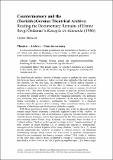Files in this item
Countermemory and the (Turkish-)German theatrical archive : reading the documentary remains of Emine Sevgi Özdamar’s Karagöz in Alamania (1986)
Item metadata
| dc.contributor.author | Stewart, Lizzie | |
| dc.date.accessioned | 2015-03-19T09:31:09Z | |
| dc.date.available | 2015-03-19T09:31:09Z | |
| dc.date.issued | 2013 | |
| dc.identifier | 175124126 | |
| dc.identifier | c88af46e-beaa-443f-9c66-0f0ae3552b17 | |
| dc.identifier.citation | Stewart , L 2013 , ' Countermemory and the (Turkish-)German theatrical archive : reading the documentary remains of Emine Sevgi Özdamar’s Karagöz in Alamania (1986) ' , Transit , vol. 8 , no. 2 , pp. 1-22 . | en |
| dc.identifier.issn | 1551-9627 | |
| dc.identifier.uri | https://hdl.handle.net/10023/6261 | |
| dc.description.abstract | Theatre history stands in a curious relation to the archive: created from physical, archival documents it then itself helps constitute or contest the ‘cultural archive’ which the ‘imagined community’ of a particular area, institution, state, or tradition, draws on. While Turkish-German literature has frequently been invoked in German studies and beyond as a ‘cultural archive’ which preserves ‘counter-narratives’ (Seyhan 3-4), or indexes a ‘transnational’ conception of the Federal Republic of Germany (Adelson 15), until very recently little research has focused on Turkish-German theatre’s possible contribution to such an ‘archive’. This can be seen most clearly with respect to the academic reception of the doyenne of Turkish-German literature, prize-winning author, actress, and director, Emine Sevgi Özdamar. Despite a focus in the secondary literature on performativity or theatrical elements in Özdamar’s prose work, the writer’s actual theatrical output, which includes six plays, has remained largely overlooked. As a result, these plays have taken on almost mythical status in Özdamar scholarship – while often referred to, they are barely researched. In this article, I use the documentary remains of the premiere of Özdamar’s first play, Karagöz in Alamania, (dir. Özdamar, 1986) to move beyond an understanding of the premiere based solely on the written record of the play. In doing so I intend to show how a return to the physical archival remains of a Turkish-German theatre sheds light on the institutional and aesthetic contexts in which productions take place and which help determine their perceived success or significance. In conclusion I suggest that much as Özdamar’s novels are often considered to preserve what Azade Seyhan calls ‘a form of countermemory to official history’ (149), the documentary remains of her 1986 production, may be said to preserve a form of counter-memory to the written records of the play. Given current discussions within the German theatrical scene on who theatre as a public institution should serve and how it should change to reflect the increasingly diverse face of modern Germany, the preservation of this ‘countermemory’, may become of increasing relevance. | |
| dc.format.extent | 22 | |
| dc.format.extent | 10801802 | |
| dc.language.iso | eng | |
| dc.relation.ispartof | Transit | en |
| dc.subject | Turkish-German Studies | en |
| dc.subject | Theatre | en |
| dc.subject | Archive | en |
| dc.subject | Özdamar | en |
| dc.subject | Emine Sevgi Özdamar | en |
| dc.subject | Karagöz in Alamania | en |
| dc.subject | Post-migrant Theatre | en |
| dc.subject | Memory | en |
| dc.subject | Abisag | en |
| dc.subject | PN2000 Dramatic representation. The Theater | en |
| dc.subject.lcc | PN2000 | en |
| dc.title | Countermemory and the (Turkish-)German theatrical archive : reading the documentary remains of Emine Sevgi Özdamar’s Karagöz in Alamania (1986) | en |
| dc.type | Journal article | en |
| dc.contributor.institution | University of St Andrews. German | en |
| dc.description.status | Peer reviewed | en |
| dc.identifier.url | http://escholarship.org/uc/item/0fq2m874 | en |
This item appears in the following Collection(s)
Items in the St Andrews Research Repository are protected by copyright, with all rights reserved, unless otherwise indicated.

